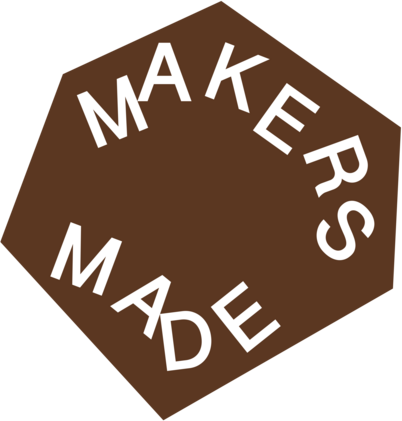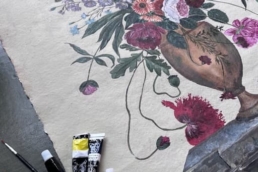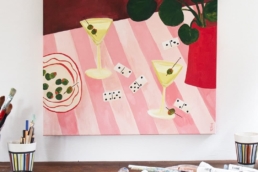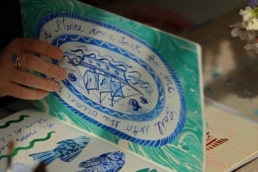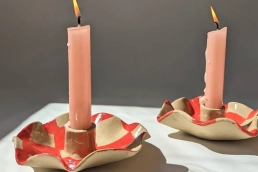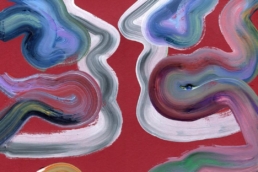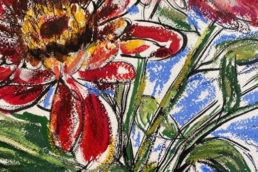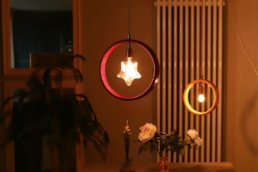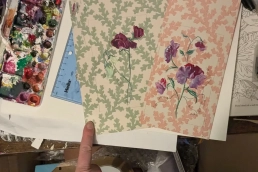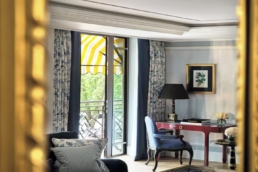In this Q&A, we talk with Emily Forgot about her journey from commercial illustration to creating her distinctive artworks and assemblages.
Emily shares her insights on balancing commissioned projects with personal creations, the materials that drive her practice, and how architectural influences shape her bold and colourful aesthetic.
We also delve into her experiences overcoming creative challenges, finding inspiration in history and design movements, and her advice on navigating life as a creative professional.

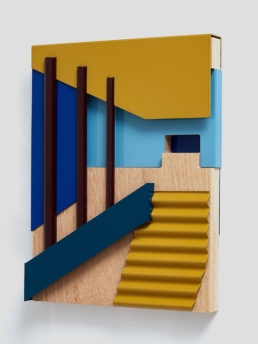
1. Can you tell us a bit about yourself and your artistic journey?
I started my creative career working as a commercial illustrator. I still do work with clients on collaborative projects but creating my own pieces both commissioned, for galleries and for my online shop has become a larger part of my practice over time.
2. What inspired you to pursue your craft? Was there a defining moment or influence that sparked your passion?
Its been an evolving process, and in many ways I feel the pursuit of my craft is often shifting. I definitely decided to work on more personal projects as I craved the freedom to direct my own output without commercial restraints. I enjoy the balance though of working to a brief set by a client and my own endeavours.

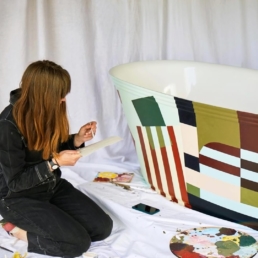
Your craft
3. How would you describe your work in three words?
Bold, colourful, architectural
4. What materials or techniques do you use, and why are they important to your process?
I’ve started using a lot of found papers in my collage work, I like how it adds a neutral tone to my overall colour palette but these found papers also give the pieces a lovely tactile quality. I also use wood in my assemblage pieces, usually poplar or ply when painted but I’m excited to explore more raw wood pieces using oak and cherry in the future. I love the robustness of working with wood.
5. Can you tell us about a favourite piece you’ve created and the story behind it?
I recently completed a commission in a building that used to be a newspaper head quarters . I was inspired by the negative spaces of letterpress type blocks for the graphic shapes in the piece. I like when there is a hidden link or narrative in the artwork. That the viewer can see what they wish to but I know as the maker how the forms and the shapes developed. I love looking at the history of a building or site to find a cue about how to develop a piece of work.
Creative process
6. What does a typical day in your studio or workshop look like?
I try to get admin tasks done first thing so I can focus on the creative side of my business. Its lovely to have a few projects at different stages all running at the same time so I can be really productive. As one piece might be drying , I can start designing another, or exploring what colour palette I might use for the next piece and making sketches. I tend to use the late afternoon to do any packing or more mindless activities as its when my focus can begin to dwindle.
7. Do you have any unique rituals or habits that help you stay creative?
Forcing myself to take a brisk walk always seems to help with my creativity.
8. How do you handle creative blocks? Do you have any strategies or tips for overcoming them?
I think going to the library can be very helpful or just thumbing through some of my own books. I have a nice collection of vintage books and magazines in the studio. They explore different periods in art and design as well as different creative disciplines from architecture to fashion, fine art, graphic design and interiors. I’m usually guaranteed to find something that might spark an idea or find a new direction to get excited about.
Challenges and successes
9. What’s the biggest challenge you’ve faced as a maker, and how did you overcome it?
I think its often about construction, finding new ways to do something with any limitations that might be presented. and finding collaborators that care as much as you do about the final outcome can sometimes be a little tricky.
10. What’s been your proudest moment or achievement so far?
Many of them happened in a year I got totally burnt out so couldn’t enjoy them fully. Looking back Selling limited edition work in the V&A designed and inspired by the building felt like a great ‘pat on the back’ moment and having my home and work featured in my favourite magazine ‘World of interiors’ was a bit of a pinch me moment. But as i said the burn out has really made me re-assess the meaning of success and how I frame achievement.
11. What’s your favourite quote you’ve ever heard about your work? Who said it, or what was the name of the publication?
“Thats cool” – About one of my rugs I put on the landing at home – my 3 year old son : )

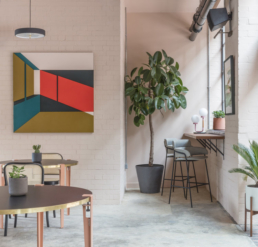
Inspiration
12. Where do you draw inspiration from for your work? What sparks your imagination and creativity?
I know it may sound cheesy but i really do draw inspiration from everywhere. I think it is this combination of multiple influences colliding with your own sensibility that makes your work truly your own and gives it that element of originality that we all crave as creative people.
13. Do you have a favourite artist, maker, movement, or tradition that has influenced your craft?
Its a real cacophony and changes often as I make new discoveries. I’ve loved revisiting the vibrant works of Sonia Delaunay lately, particularly her textiles and I got a great book on the Wiener Werkstätte recently. In terms of movements I love design movements that touched all areas of creativity from weaving to woodwork.
The Bauhaus, of course, being a perfect example of this multi disciplinary approach. I love early modernism but equally love to dip my toe in the less serious and more playful movements like Memphis of the 1980’s. I’m just excited to be a fan of it all and how it influences me often comes secondarily.
14. How does colour influence your practice; is it an important part of your process? Do you have a particular palette or favourites? Any go-to sources for colour inspiration?
Colour is a huge part in what makes my work unique to me. I love how intuitive building colour palettes can be. I don’t have a particular signature palette but the colours are often vibrant but with a little bit of earthiness to ground them. I often limit my palette too so usually no more than 3-4 colours. There is a great Japanese book on colour palettes that are extracted from kimonos that I love www.waterstones.com. Its a great resource if you are feeling like you need some guidance. I also love looking at fashion designers too and my own palettes are often led by the seasons.
"Thats cool"
— About one of my rugs I put on the landing at home. (my 3 year old son)
Perspectives and goals
15. What role does your environment play in shaping your creativity?
I think it plays a big role … just the right amount of mess, too much and its overwhelming.
16. What do you want people to feel when they experience your work?
Happy, energised, inspired …hopefully.
17. What are you currently working on, and what excites you most about it?
I’m working on some large scale commissions, both collage and wooden assemblages. Both are in the research stages and need to be inspired by the site they will be displayed so I’m in my favourite stage, exploring colour, shapes and architecture and making initial sketches.
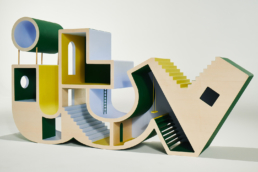
Advice and reflection
18. What advice would you give to someone starting out as a maker?
Spend some time trying to figure out where your true passion and interest lies and don’t put too much pressure on the objects you make being your sole source of income at the start . I still have a few different ways that I make a living within the creative Industry and a large part of this is commissioned projects with set briefs. This excites me in different way to my more personal work but I think the self initiated creations would suffer if I relied solely on them to make ends meet.
19. If you could go back to the start of your career, what advice would you give your younger self?
I don’t know if i would offer any advice as think all the mistakes and wrong turns led me to where I am today. So perhaps it would just be, “You’re on the right path, keep going!” oh and also to trust my gut more, projects that even have a whiff of a red flag are usually going to be rife with issues.
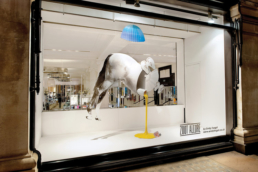
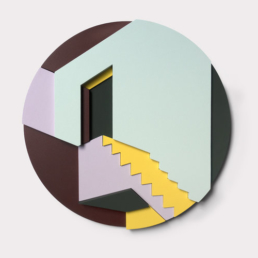
Closing thoughts
20. If you could collaborate with any artist, past or present, who would it be and why?
I would have loved to have been Eileen Gray’s apprentice. Because she was an innovative genius and what more do you need in a mentor! I’m not sure if many of the designers and artists i admire would have really been up for the idea of collaborating, their focus was very much on their personal vision but to be honest I would be happy to just make tea and observe.
21. Where can people find your work, and how can they support you?
I have a website emilyforgot.co.uk that shares my commissioned projects and also has a shop, emilyforgot.co.uk/shop, I sell pieces through the galleries Partnership Editions and M.A.H and rugs through Floor story. I also run a Substack called Soft fascination, where I share inspirations both past and present, becoming a paid subscriber is a lovely way to support my practice too.
Emily Forgot’s work is a joyful exploration of colour, form, and playful architectural references, blending found materials and bold shapes into striking, contemporary pieces. From collage art to wooden assemblages, her creations offer viewers moments of inspiration and delight.
Explore Emily’s latest collections and follow her creative journey:
Support Emily by subscribing to her Substack and exploring her beautiful pieces online.
